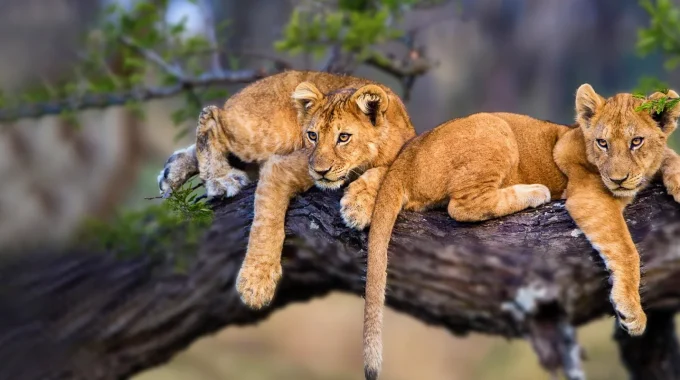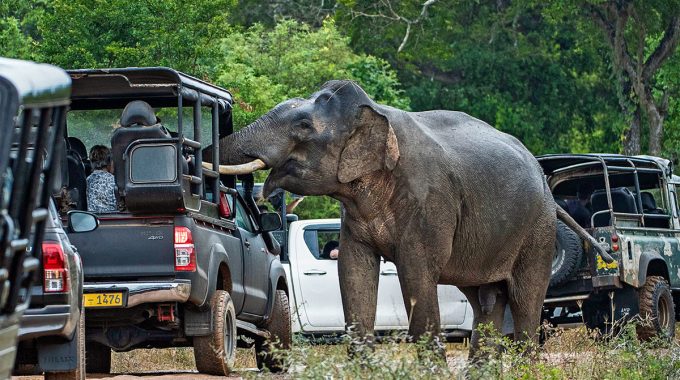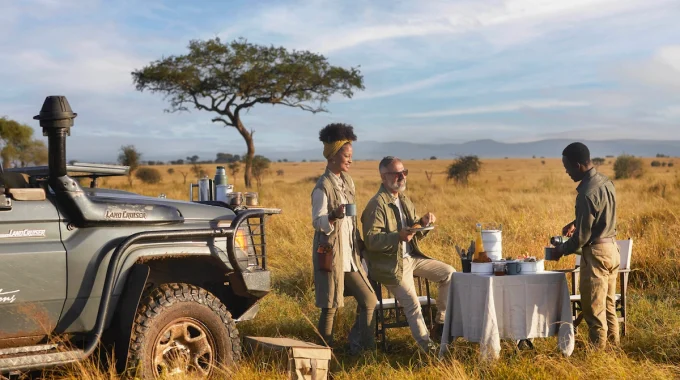Your Big African Safari Planner: What to Expect from the Top Safari Countries in 2025…
The Most Popular FAQs About African Safari Animals – Answered
African Safari Animals FAQ: If you’re dreaming of an African safari adventure, you’re likely brimming with curiosity about the incredible wildlife awaiting you. This comprehensive guide answers the 15 most frequently asked questions about African safari animals to help you prepare for your journey into the wild.

1. What are the Big Five animals of Africa?
The “Big Five” refers to five of Africa’s most iconic and sought-after animals: lion, leopard, elephant, rhino, and buffalo. Originally a term coined by big-game hunters to describe the most difficult animals to hunt on foot, it has now become a top safari bucket list for wildlife enthusiasts and photographers alike.
These animals can be seen in several African countries, including South Africa, Kenya, Tanzania, Botswana, and Namibia. National parks like the Serengeti, Kruger, and Maasai Mara are prime locations for spotting all five.
2. What animals am I most likely to see on safari?
While the Big Five are the stars of the show, you’ll likely encounter many other fascinating animals during your safari. Commonly seen species include:
- Giraffes
- Zebras
- Wildebeest
- Impalas and antelope
- Hippos
- Crocodiles
- Warthogs
- Baboons and monkeys
Your sightings will depend on the region, the season, and the type of safari you book—whether it’s a traditional game drive, walking safari, or river safari.
3. When are animals most active on safari?
Most African wildlife is most active during the cooler parts of the day—early morning and late afternoon. Midday heat often drives animals to rest in the shade or retreat to hidden areas, making these times less productive for wildlife viewing.
This is why most game drives are scheduled shortly after sunrise or before sunset, when predators are hunting, herbivores are grazing, and the light is perfect for photography.
4. What are the rarest animals to see on safari?
Some animals are elusive and more difficult to spot due to their nocturnal habits, camouflage, or low population numbers. These include:
- Leopards – secretive and solitary
- Black rhinos – critically endangered and shy
- Wild dogs – rare, fast-moving hunters
- Pangolins – nocturnal and heavily trafficked
- Aardvarks and servals – mostly active at night
Your chances improve with experienced guides and in private conservancies or national parks with fewer vehicles and off-road tracking options.
5. Are birds a big part of an African safari?
Absolutely. Africa is a birdwatcher’s paradise with over 2,300 bird species, including both endemic and migratory birds. From giant ostriches to dazzling lilac-breasted rollers and powerful martial eagles, the variety is staggering.
Even casual safari-goers will notice the diversity and beauty of Africa’s birds. Binoculars and a birding guidebook can make your experience even more rewarding. Some areas, like Botswana’s Okavango Delta or Uganda’s forests, are global birding hotspots.
6. What other unique African safari animals can I see?
Africa is home to more than just the Big Five. The continent boasts an astounding variety of unique and rare African animals that make every safari special. Depending on your destination, you might see:
- Mountain Gorillas in Rwanda and Uganda
- Chimpanzees in Uganda’s Kibale Forest
- Lemurs in Madagascar’s rainforests
- Whale sharks and dugongs off the coast of Mozambique
- Gerenuk (the giraffe gazelle) in Kenya
- Ethiopian wolves in the Bale Mountains
These creatures are part of Africa’s lesser-known but equally captivating wildlife. Many are endangered African species, and seeing them in the wild is a rare and privileged experience. Consider booking specific treks or visits to reserves focused on conservation to increase your chances of sightings. See our guide to Africa’s rare and endangered animals.
7. How close can I get to the animals on safari?
Respecting wildlife distance is crucial on any safari. Most African safari animals are habituated to vehicles and will not flee if you remain quiet and respectful. You can often get surprisingly close—sometimes within a few meters—especially if you’re with a seasoned guide who knows how to approach without disturbing the animals.
However, safaris are designed to protect animals and visitors. You should never try to touch, feed, or exit the vehicle to approach animals unless instructed by a guide during a controlled experience (such as a gorilla trek or walking safari).
Many lodges and national parks enforce strict wildlife-viewing regulations to ensure safety. Abiding by these rules ensures a low-impact experience and protects both the ecosystem and future visitors. Learn more about ethical wildlife viewing.
8. Are predators dangerous to humans?
Predators like lions, leopards, and cheetahs are potentially dangerous, but safari-goers are rarely at risk if they follow the rules. These African carnivores typically do not see safari vehicles as prey or threats, allowing for incredible close-range encounters from the safety of a game drive.
Most incidents arise when people disregard guidelines—such as standing up in open vehicles or walking unsupervised. Always stay inside your vehicle unless you’re on a guided walking safari. Your guides are highly trained in animal behavior and carry the necessary equipment for safety.
With thousands of tourists on safari annually, dangerous encounters are statistically very rare. Read about how to stay safe around African predators.
9. What about dangerous snakes and insects?
While Africa is home to some venomous snakes and biting insects, encounters with them are uncommon on safari—especially when following basic safety tips. The most common nuisances include:
- Tsetse flies – painful bites, present in woodland areas
- Mosquitoes – potential malaria risk, especially in wetter months
- Scorpions – found in arid areas, usually avoid human contact
To reduce your risk:
- Use insect repellent daily
- Wear long-sleeved clothing and closed shoes
- Shake out shoes and clothing before wearing
- Sleep under a mosquito net where provided
Snake bites are extremely rare as snakes avoid humans. Still, remain vigilant and avoid tall grass or bush areas when walking. See our safari health and safety tips.
10. What should I do if I encounter safari animals on foot?
If you find yourself on foot near wildlife, remain calm. Never run—this can trigger a chase response from predators. Instead, maintain eye contact and slowly back away while facing the animal. Don’t make sudden movements or loud noises.
If you’re with a trained guide (such as on a walking safari), follow their instructions carefully. Guides know how to read animal behavior and can prevent escalation. Wild animals usually avoid confrontation if given space and time to retreat.
This is one reason walking safaris are always guided in Africa. Whether you’re tracking rhinos in Zambia or gorillas in Rwanda, your guide’s primary job is ensuring everyone’s safety. Read more about how to handle wildlife encounters.
11. When is the best time to see specific animals?
The best time to go on safari depends on what animals you want to see and where you’re headed. For example:
- The Great Migration is best viewed from June to September in Kenya’s Maasai Mara and December to March in Tanzania’s Serengeti.
- Gorilla trekking is great year-round in Rwanda and Uganda, but drier seasons (June–September, December–February) are easiest for hiking.
- Birdwatching is especially good from November to April in southern Africa when migratory birds are present.
Dry seasons generally offer better wildlife visibility as animals gather near water sources. Check our safari calendar by country and season.
12. What animal sounds will I hear at night?
Nighttime in the African bush is filled with unique and haunting sounds. Depending on your location, you might hear:
- The deep roar of a lion echoing across the savannah
- Whooping hyenas communicating with their clan
- Elephants trumpeting or rumbling
- Hippos grunting in nearby rivers or ponds
- Bats and crickets providing a soft, constant background
Hearing these sounds from the comfort of your tent or lodge is one of the most unforgettable parts of a safari experience. Discover more about African wildlife vocalizations.
13. Can I see baby animals on safari?
Yes! Baby animals are a highlight of any safari and are most commonly seen during birthing seasons, which vary by region:
- Wildebeest calves are born en masse in the Serengeti from January to March
- Elephant and zebra births often occur at the beginning of the rainy season
- Predator cubs like lion and leopard kittens may be spotted year-round, hidden in dens or suckling from mothers
Local guides often know where to find young animals, especially in private reserves with active monitoring. Read more about safari baby animal seasons.
14. Will I see animals near my lodge or camp?
In many safari regions, animals roam freely through camps and lodges. It’s common to see:
- Elephants or giraffes walking past your tent
- Baboons and vervet monkeys exploring the grounds
- Hippos grazing near riverside lodges
Most lodges have staff to escort guests safely at night, and rooms are built with animal-safe structures. Always follow camp rules and stay aware. Tips for staying in the wild with wildlife.
15. What animals are active at night?
Many African animals are nocturnal, and a night game drive can reveal a whole new world. Creatures commonly active after dark include:
- Lions – more active hunters at night
- Hyenas – often scavenging or hunting in packs
- Genets and civets – small, elusive carnivores
- Porcupines and bush babies
- Owls and other night birds
Night safaris are often offered in private reserves or conservancies where spotlighting is allowed. Find out how to book a night safari experience.



